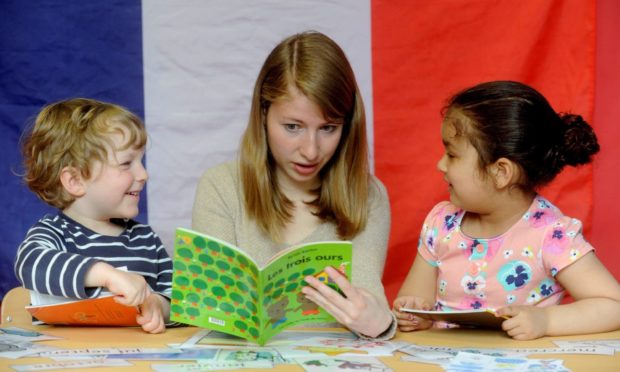Scottish schools are undergoing a revolution in foreign language learning in an attempt to reverse generations of neglect.
After years of being derided as ‘lazy’ linguists abroad, there are plans to produce a multilingual workforce.
Few school systems demand less foreign language learning from their children than those in the UK.
This is not helped by having a native language that is the ‘lingua franca’ of the world.
But a Scottish Government policy is setting out to change all that.
Under the 1+2 Languages initiative, pupils will learn their own language (L1) plus two others (L2 and L3).
The L2 will be taught from Primary 1, and the L3 from Primary 5 to 7. There will be compulsory teaching of at least one foreign language until S3.
Education bosses will fully implement the “ambitious” policy for the start of the 2021-22 school year.
Based on the last Scottish Government survey in 2019, 88% of primary schools – approximately 1,760 schools – were delivering the full L2 entitlement.
This already represents significant progress. Anyone in their 30s who went to a Scottish state school won’t have studied foreign languages until secondary school.
The Scottish Government has spent more than £45million since 2013 on increasing foreign language learning in schools.
Teachers are currently being provided with training and support in readiness for the changes.
‘Broader international perspective’
Dr Colin Christie, lecturer in modern languages teacher education at the University of Aberdeen, said the changes would be of enormous benefit to pupils upon leaving school.
“The 1+2 Languages initiative is a positive step in introducing primary learners to the joys of learning languages,” he said.
“The wider benefits of language learning include an openness and awareness of other cultures, increased confidence in communication, a development of cognitive abilities and an improved understanding of one’s own language.
“This is as well as a broader international perspective.”
Schools will integrate foreign languages into classroom life and routines. This can range from chat about choosing lunches to talking about the weather.
Teachers will introduce the second foreign language, or L3, in P5 to P7. This offers the chance to introduce a less widely-taught language.
“There is no hierarchy of languages and the language chosen by the school can fit local contexts and celebrate and build upon languages other than English used within the community,” said Dr Christie.
“French does continue to be to the dominant language.
“This is for historical reasons, and also due to the teaching expertise available.
“There are however steps being taken to diversify the languages on offer and make the teaching of Mandarin Chinese more widely available.
“Mandarin Chinese is on offer in some schools in Aberdeen City but any development like this clearly takes time.
“French is still the dominant language in terms of, for example, National 5 entries but Spanish, German and Mandarin Chinese do also feature.
“Of those four languages, French accounts for about 53%, Spanish 34%, German 12% and Mandarin Chinese just over 1%.”
Languages ‘open doors’
Learning a foreign language has benefits beyond the obvious linguistic ones, opening doors that would otherwise remain closed.
He added: “In terms of secondary provision, languages are an entitlement up to S3 and the debate as to whether they should be compulsory beyond that is a long-standing one.
“I think many linguists would love for a modern language to be seen as a life skill that should be studied by all.
“However, this is a complex debate due to issues of staffing and also the danger of turning pupils off of language learning due to its compulsory nature.”
A Scottish Government spokesman said: “Learning languages equips young people with the skills needed for an increasingly complex and globalised world. It helps build literacy and fosters tolerance and respect.”
A spokeswoman for Education Scotland added: “Confidence in knowing other languages and understanding other cultures are 21st century skills for students as they prepare to live and work in a global society.”

